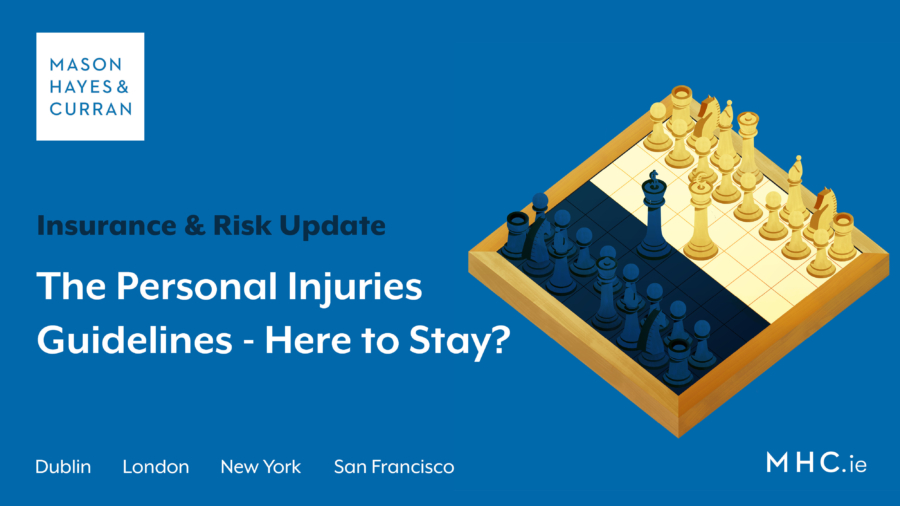
The Personal Injuries Guidelines have weathered their first constitutional challenge, but what lies ahead? Our Insurance & Risk team reviews the impact of the High Court decision in Bridget Delaney v the Personal Injuries Assessment Board & Others.
Not everyone is happy with the introduction of the Personal Injuries Guidelines. A High Court decision of Mr Justice Meenan in Bridget Delaney v the Personal Injuries Assessment Board & Others[1] saw Ms. Delaney’s constitutional challenge to the Guidelines fail.
Background
On 12 April 2019 Ms. Delaney fell on a footpath, fracturing her ankle and grazing her knee. A medical report from a consultant orthopaedic surgeon noted there would be no significant long-term injury. Her ankle was placed in an orthopaedic boot for several weeks.
The Personal Injury Guidelines (Guidelines) became operative on 24 April 2021.
On 21 May 2021, PIAB assessed Ms. Delaney’s injuries under the Guidelines and awarded her general damages of €3,000. It is estimated that if the Book of Quantum had been used, she would likely have received an award of damages in the region of €18,000 to €34,000.
The challenge
In her High Court proceedings, Ms. Delaney challenged both the constitutionality of the Guidelines and PIAB’s application of the Guidelines to assess her award for general damages. The main arguments put forward were:
- That the adoption of the Guidelines by the Judicial Council was in breach of the Constitution and the separation of powers
- The enactment into law and assessment under the Guidelines resulted in a lower award of general damages resulting in a retrospective interference with Ms. Delaney’s constitutional rights. Specifically, her constitutional rights of property, bodily integrity and equality were interfered with
- The Judicial Council acted outside its powers in adopting the Guidelines
PIAB erred in law by applying the Guidelines, and not the Book of Quantum, when assessing its award of damages
The High Court decision
The High Court rejected the constitutional challenge. In its decision, the High Court considered the well-established principles for awarding general damages, the Judicial Council Act 2019, and the principles and policies followed by the Personal Injuries Guidelines Committee in drawing up the Guidelines.
The High Court held that:
- The Personal Injuries Guidelines Committee methodically followed the principles and policies as directed by the Oireachtas in the Judicial Council Act 2019
- There is no encroachment on judicial independence as there is provision for a court to depart from the Guidelines, provided that proper reasons for doing so are furnished
- Ms. Delaney had a right to have her damages assessed in accordance with well-established legal principles but had no constitutional right that entitled her to a particular sum of damages
- PIAB was not incorrect in applying the Guidelines to Ms. Delaney’s assessment, even though the accident occurred before the Guidelines were approved
- The High Court was satisfied that the case raised novel issues concerning the principles of delegated legislation. It was brought as the lead test case on the constitutionality of certain elements of the Guidelines, in the public interest. Therefore, Ms. Delaney was entitled to 60% of her legal costs against Ireland and the Attorney General.
Conclusion
The High Court decision was appealed and the Supreme Court has recently agreed to hear a “leapfrog” appeal, meaning that the case can bypass the Court of Appeal. The Supreme Court agreed that the case involved issues of such importance that a direct appeal to that court was warranted.
We are aware of other similar challenges waiting in the wings but these remain adjourned until a final decision is reached in Ms. Delaney’s case by the Supreme Court.
In the meantime, the High Court decision means that PIAB and the courts can continue to assess awards of damages under the Guidelines. The decision by the Supreme Court will be eagerly awaited as it will determine if the Guidelines are here to stay.
For more information, please contact a member of our Insurance & Risk team.
The content of this article is provided for information purposes only and does not constitute legal or other advice.
[1] [2022] IEHC 321
Share this:






